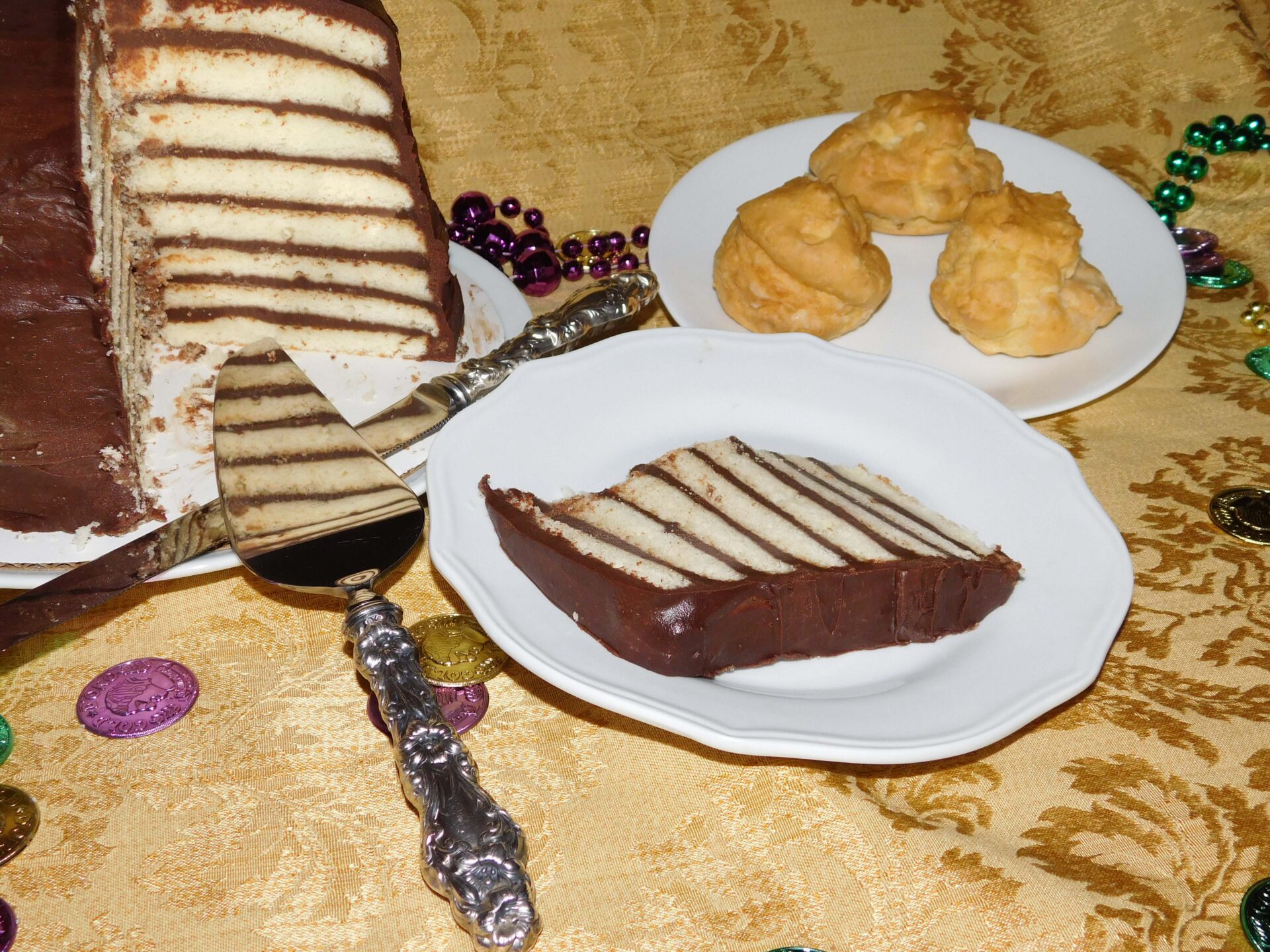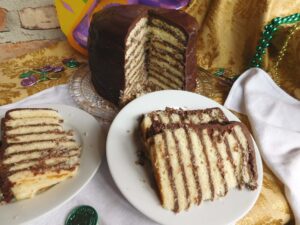Eating Oxford
On Cooking Southern: Super Mardi Gras Pastries Bowl Us Over
SOUTHERNISM OF THE WEEK
Good enough to slap in a biscuit: Self-explanatory expression of delight… that somebody or something is so deliciously fine that it could only be improved by positioning it in a good ol’ Southern-style biscuit, which folks around here all know is the best way to consume anything.
CREAM PUFFS AND DOBERGE CAKE ARE SWEET ANY OL’ TIME
Laissez les bons temps rouler, y’all. This is one of those years when Mardi Gras overlaps with Super Bowl season. That means it’s time to party, times deux.
As the late, great comedian-actor Jackie Gleason would say, “How sweet it is.”
Folks around here are in a party mood, anyway. We all had a fine collegiate football season, recruiting for next year is going well, and the Sheriff (Peyton Manning, of Mississippi first-family Manning fame) and his Denver Bronco teammates are headed for Santa Clara, CA, on February 7. They’ll match up in Super Bowl 50 against Carolina Panthers young’un, Cam Newton, and his Mississippi-connected teammates such as Michael Ohr.
Oh how sweet it is, indeed.
The Old Bride intends to comingle football food and Mardi Gras food for the next three weeks because Super Bowl Sunday falls the day before Lundi Gras, two days before Fat Tuesday, and three days before Ash Wednesday.
This week, we are exploring two sweets that are part of our region’s mish-mashed culinary heritage. We all know about Mardi Gras King Cake, a brioche rolled and filled with nuts and fruit and spices and a plastic baby Jesus; topped with icing in the season’s religious colors of green, gold and purple. (Click here for my recipe).
But the Deep South world of Mardi Gras pastries contains other exotic yet simple flavors. One of them is the cream puff, also known as the profiterole. The other is the doberge cake.
Cream puffs were a staple in the Delta and Mid South of this Baby Boomer’s childhood. Variations of the pastry were made up for company appetizers (think ham puffs) as well as for desserts. My cousin taught me how to make them, having been taught by her mother, who was taught by our great-grandmother. They are so easy to make that this cook is kicking herself for not making them more often. Nothing is tastier when they are fresh.
The cream puff possibly originated in 13th century France and southern Germany, where chefs learned to cook flour dough, eggs, fat and water together to create a puffed-up, hollow pastry. The hollow interior was the perfect platform for savory cheeses, meat pastes, or sweet cream and chocolate.
Unlike cream puffs, the Doberge Cake is New Orleans-specific. It is a 20th century interpretation of the classic Hungarian Dobos/Dobosh, a custard-filled torte containing five to eight sponge-cake layers.
Beulah Levy Ledner is acknowledged as the creator of the Doberge Cake. Around 1933, seeking a new pastry for her NOLA bakery, she modified an Alsatian family recipe and based the modification on classic Hungarian dobos torte. To make the pastry sound more French, she changed the Dobos name to Doberge. The name stuck and the cake/torte became a hit. Crescent City residents pronounce it “dough-bosh” or “dough-bash.”
Mrs. Ledner sold her shop and her recipes in 1946 to Joe Gambino (Gambino’s Bakery), and in 1981 at the age of 87, sold her second bakery and (again) her doberge recipe to Maurice’s French Pastries. To this day, doberge is the must-have birthday cake/torte for NOLA residents. Versions with fillings of half lemon and half chocolate custard sell by the thousands at most local bakeries during Mardi Gras.
PAPA’S CREAM PUFFS
Some versions call for starting the baking at 425˚F for 10 minutes, then lowering the temperature to 375˚F. My Aunt Sheila baked at 400˚F for 35-plus minutes. This worked for me! Under-baking the pastry results in eggy, wet interiors that are not completely hollow. Too-high heat burns the tops.
Pastry:
1 c water
1 stick butter
1 c flour
4 eggs
Bring water and butter to boil in a medium (3 qt) saucepan. Add 1 c flour. Cook, stirring until it sticks together in a ball and keep stirring vigorously until all flour clumps are blended. Remove from heat and cool for one or two minutes. Add eggs into the pan, one at a time. Beat vigorously with wooden spoon until completely smooth. The dough will be wet but elastic.
Spoon about 2 heaping tablespoons at a time onto ungreased cookie sheet or baking pan, placing each about 2 inches apart. Bake at 400- to 425˚F for 30-40 minutes on middle rack until puffed more than double in size and evenly browned. Remove from oven, using metal spatula to gently loosen from pan if stuck. Cool completely.
VARIATION: To make éclairs, use a pastry bag and squeeze out the dough in 4 or 6-inch-long lozenge shapes on the baking pan. After filling with custard or whipped cream, dip in chocolate ganache and place on waxed paper for chocolate to set up.
Classic Custard Filling:
1-1/2 c whole milk
1/2 c evaporated milk
1/3 c flour
3/4 c sugar
2 eggs
1 tsp vanilla extract
Combine in saucepan. Cook until thick. Cool and chill.
Slice an opening along one side of each puff, and spread opening wide enough to insert teaspoon filled with custard. Fill hollow interior with chilled vanilla or chocolate custard, whipped cream or chocolate ganache. Serve immediately or refrigerate up to one day.
DOBERGE CAKE
The original recipe is in “Let’s Bake with Beulah Ledner,” a cookbook published privately in 1987 by her daughter Maxine Wolchansky. It also has been reproduced in the New Orleans “Times-Picayune.” I tried out Beulah’s recipe but chipped off the recipe icing—it didn’t have the sleek appearance of the tortes I’d seen in Vienna last November, nor did it look like the Gambino’s doberge cakes of my experience. I substituted a pourable chocolate ganache, which was perfect. “Ganache” is a fancy French term for a glaze or icing made by pouring heated cream over chocolate.
Torte:
1-1/2 sticks (12 T) salted butter, room temperature
2 c white granulated sugar
1/4 tsp fine kosher salt
4 large eggs, separated, the whites beaten stiff
1 c whole milk
3 tsp baking powder
3-1/2 c cake flour, measured after sifting
Scant tsp lemon juice
1 tsp vanilla extract
Sift dry ingredients and set aside. Place a non-reactive mixing bowl in the freezer. Bring eggs to room temperature (about 30 minutes).
Preheat oven to 375˚F. Cut out parchment circles to fit bottoms of 9-inch cake pans (or clean Sister Schubert roll pans, which are the perfect size and allow the cook to prep all 8 pans at one time). Dot with shortening on bottoms of pans before sticking down the parchment. Smooth out paper; grease bottoms, and up the sides about 1 inch.
Cream butter, sugar and salt until smooth. Separate the yolks and whites; add egg yolks to the butter-sugar mixture, one at a time, mixing until smooth. Beat in the sifted dry ingredients, alternating with milk, until well blended. Mix in the vanilla and lemon juice.
Beat the whites in chilled bowl until they form stiff peaks. Use spatula to fold beaten egg whites completely into batter, folding and stirring only in one direction to retain the air bubbles. Use a measuring cup to pour 3/4 cup of batter into each pan, spreading the batter evenly over the bottom. HINT: Turn the pans as you spread, using a spatula and working outward from the center until batter touches the sides.
Depending on oven size and evenness of baking temperature, bake 2 to 4 pans at a time on the middle rack for about 12 minutes until cakes pull away from the sides. Remove pans to cool. Flip cooled cakes onto wax paper and remove parchment. Repeat until all pans have been baked.
Chocolate Custard Filling:
2 c white granulated sugar
1/2 tsp table salt
4 T all-purpose flour
4 T cornstarch
8 T cocoa (don’t skimp)
2 oz of bitter or unsweetened chocolate
4 large eggs
1 T vanilla extract
4 c (1 qt) whole milk
Combine all dry ingredients in a 3-quart saucepan and whisk to blend. Loosely beat the eggs and combine with the milk and vanilla. Add wet ingredients and unmelted chocolate to the saucepan. Cook on medium heat, stirring constantly with a wooden spoon and a spatula until all specks of chocolate have melted and custard is velvety thick. Remove from heat to cool completely.
Position first cake layer onto a cardboard cake round positioned on a plate that is positioned on top of 3 strips of aluminum foil long enough to wrap around eight stacked layers. Use large kitchen spoon and ladle about 3 heaping scoops onto each layer, spreading out from the center until seven cake layers are evenly covered. Do not cover the eighth (topmost) layer. Wrap loosely in foil and refrigerate overnight.
Easy Ganache Icing:
12-oz pkg semi-sweet chocolate chips
1-1/2 c heavy whipping cream
Place the chocolate chips in a non-reactive metal bowl. I use the double boiler bowl for my 3-quart double boiler saucepan because the pan lid fits the bowl.
Heat the cream in a saucepan, scraping sides and stirring with a silicone spatula to prevent scorching, until the cream almost reaches boiling stage. When the cream is bubbling evenly (not just around edges), pour it over the chocolate chips and swirl once in the bowl to ensure all chips are coated. DO NOT STIR CHIPS. Cover and set timer for 5 minutes.
Remove lid at end of 5 minutes and use a whisk to stir, working out from the center. Continue stirring until mixture changes colors and becomes smooth. Stir more until all bits of chocolate have melted and mixture is dark and velvety in texture. Set timer for 15 minutes and allow chocolate to sit at room temperature (about 70˚F) to begin setting up.
Pull cake out of fridge and position (still on the cake round) on a rack over a large baking pan. Have second baking pan handy. Pour ganache evenly over the top, starting in swirls from the center. Use a silicone spatula as a guide as the ganache drips down the sides. Lift rack containing cake and position on second pan. Use soft spatula to scrape ganache to a corner in first pan; pour it over cake.
Repeat process until cake has been completely coated and most of the ganache has been used. Allow coated cake to sit for about 20 or 30 minutes; use a cake spatula to work cake loose from cake round and slide it onto a serving plate or cake plate. Smooth out the ganache along sides. Refrigerate or freeze until ready to serve. HINT FOR FREEZING: Place unwrapped cake in freezer for one hour to harden the ganache. Remove from freezer long enough to wrap in waxed paper, foil and plastic wrap.
Laurie Triplette is a writer, historian and accredited appraiser of fine arts, dedicated to preserving Southern culture and foodways. Author of the award-winning community family cookbook GIMME SOME SUGAR, DARLIN’, and editor of ZEBRA TALES (Tailgating Recipes from the Ladies of the NFLRA), Triplette is a member of the Association of Food Journalists, Southern Foodways Alliance and the Southern Food and Beverage Museum. Check out the GIMME SOME SUGAR, DARLIN’ website and follow Laurie’s food adventures on Facebook and Twitter.
Follow HottyToddy.com on Instagram, Twitter and Snapchat @hottytoddynews. Like its Facebook page: If You Love Oxford and Ole Miss…


































